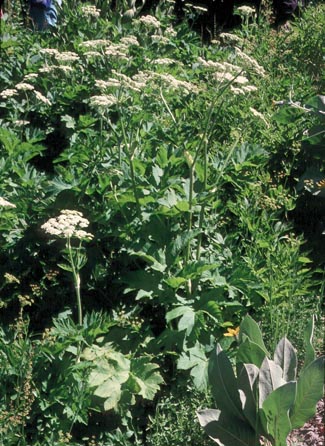Cow Parsnip

Common Name(s):
Cow Parsnip
Common Cowparsnip
American Cow-parsnip
Scientific Name:
Heracleum maximum Bartr.
Scientific Name Synonyms:
Heracleum lanatum Michx.
Heracleum montanum Schleich. ex. Gaudin
Symbol:
HEMA80
Description:
Life Span: Perennial
Origin: Native
Growth Characteristics: Cow parsnip is a native, perennial forb that grows from 3 to 10 feet (1-3 m) tall and has broad, flat-topped umbels. It grows from a stout taproot or a cluster of fibrous roots. It flowers from June through August and reproduces by seed.
Flowers: Flowers occur within a large umbel. Some flowers within the umbel only produce stamens, while others are hermaphroditic. Secondary umbels develop synchronously approximately 10 to 14 days after the primary umbel. Hermaphroditic flower and seed production may be increased by herbivory.
Fruits/Seeds: The egg-shaped fruit is 0.32 to 0.48 inch (8-12 mm) long and 0.24 to 0.36 (6-9 mm) wide.
Leaves: Leaves are 8 to 20 inches (20-50 cm) long and wide.
Ecological Adaptions:
Cow Parsnip grows throughout the United States and Canada. It occurs in a wide variety of forested habitat types, as well as grassland, shrubland, meadow, alpine, and riparian zones. In the Intermountain West, it is a common understory species in subalpine fir and Engelmann spruce habitat types, as well as in Quaking aspen communities. It is commonly found growing in snow-maintained disclimaxes such as avalanche chutes. Cow parsnip is a facultative wetland species; it grows best in moist, shaded areas but can also be found in open woodlands and clearings. In Utah, it is found at elevations of 5200-9000 feet (1560-2700 meters).
Soils: Cow parsnip grows best on moist to semi-wet soils with good drainage. It prefers loam and sandy loam soil derived from limestone and shale, but occurs on clay, clay loam, and gravelly substrates as well.
Associated Species: Narrowleaf cottonwood , bigtooth maple , western snowberry, Saskatoon serviceberry, common chokecherry, blue wildrye, field horsetail, bluejoint reedgrass, fireweed, western aster, stinging nettle, tall larkspur, Richardson's geranium, saw groundsel, and bracken fern.
Cow parsnip is a valuable forage species for livestock, deer, elk, moose, and bear. It is rated moderately good for erosion control, short-term revegetation potential, and long-term revegetation potential. It has fair soil stabilization value.
Cow parsnip is sensitive to soil compaction or severe soil disturbances which may be caused by mechanical scarification or trampling.
In high mountain ecosystems of Utah, cow parsnip should be broadcast or drill-seeded in the fall at 1 to 2 pounds per acre in a mixed seeding for best forage results.
Parsnip webworm, a European-introduced herbivorous insect, feeds on developing flowers and seeds of cow parsnip. Floral herbivory can decrease seed production by up to 40 percent and seed biomass 53 percent.
Cow parsnip appears to persist or increase after clearcutting, but to decrease after soil scarification.
Native Americans of Alaska, British Columbia, the Great Plains, and Arizona used cow parsnip for medicinal and nutritional purposes. Native Americans in Alaska ate the inside of stems raw and boiled the roots to extract sugar. In Arizona, the Apache ate the young leaves and stems and used the roots to treat epilepsy.
In the Great Plains cases of dermatitis have been reported in persons who came in contact with the foliage of cow parsnip.

